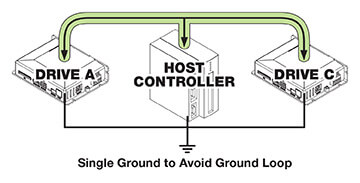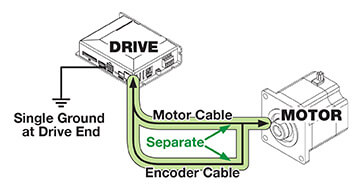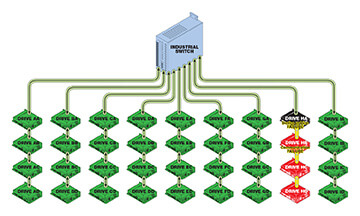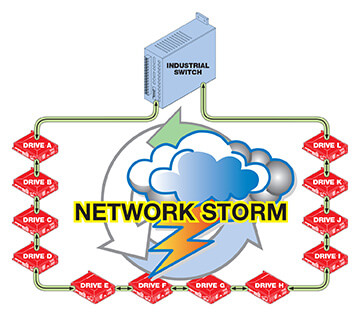Hush! Minimizing noise in electric linear motion systems
By Tolomatic on March 20, 2018
 Under most circumstances electric linear motion systems are quiet. They certainly don’t create the hissing and bang-bang noises associated with pneumatic systems. However, there’s another type of noise that comes with electric systems of all types – electrical noise or interference.
Under most circumstances electric linear motion systems are quiet. They certainly don’t create the hissing and bang-bang noises associated with pneumatic systems. However, there’s another type of noise that comes with electric systems of all types – electrical noise or interference.
This is a common occurrence caused by random fluctuations in electrical signals. If the amplitude gets high enough, electrical noise can disrupt the operation of devices like electric linear actuators. The results can be anything from erratic movements to complete system failure.
Machine designers look for ways to mitigate interference. For best practices for reducing noise in linear motion control systems, see our white paper, Minimizing electrical noise in actuator drive systems for maximum reliability and performance.
Sources of electrical noise
There are the two major sources of this noise.
Ground Loop Noise
Ground loops happen when sections of a system are connected to different earth grounds. If the earth grounds have different electrical potentials, an unwanted current will flow between them causing disruptive noise.
In industrial control systems, drives connected to the same communications bus should be connected to the same ground as the controller to avoid this interference.
Induced Noise or Electromagnetic Interference (EMI)
Sections of electrical circuits may act like antennas, picking up noise and transmitting it to nearby equipment like linear actuators. This is EMI, and it can occur near actuator servo drive systems when noise from switching signals is induced into communications lines.
Conversely, noise emitted by communications lines and power cables may be picked up by the electric linear actuator servo drive. In either case, system performance is disrupted.
Minimizing noise
How to minimize ground loop noise
We recommend using a single-point earth ground for the entire system to minimize noise. If a single-point ground isn’t possible, connect the grounds physically with a low resistance wire. (10 ohms is a good starting point.) This will limit the current flowing between the grounds, reduce the chance of a ground loo p occurring, and minimize noise.
p occurring, and minimize noise.
How to minimize induced noise
- Keep cables as short as possible. Longer cables emit and receive more noise.
- Avoid coils of wire and cable.
- Mechanically secure all cables to keep them separated.
- Separate motor and encoder cables. Keep at least 2” between them throughout their path from drive to motor.
- Use properly shielded motor and communications cables
- Ground the cable shielding on only one end of the cable.
Communications survivability
Interference can be especially troublesome for device-to-device communication (including drive-to-electric linear actuator). Here are recommendations on minimizing noise and its harmful effects on communication in factory automation systems.
Minimize noise in communications cables
- Use twisted pair cable to cancel out EMI.
- Use shielded cable that’s certified for use in an industrial environment.
- Ground the cable shielding at one end only. Grounding on both ends could create a potentially noise-emitting ground loop.
- Keep communications cables as short as possible and avoid coils.
- Secure cables to minimize wire fatigue. Too much movement can result in broken wires.

Best practices for automation system set-up
The communications links between an electric linear actuator, the drive and the PLC are vital to the linear motion control system. If communication is blocked, motion stops so the right system set-up is essential.
- Use switches and hubs that can stand up to the challenges of the environment. For better installation, network monitoring and survivability options, use a fully-managed, industrially-rated Ethernet switch for Ethernet communication.
- Daisy-chain drives intelligently. Daisy-chaining can reduce the number of network switches and the amount of cabling needed in a system; however, daisy-chaining can slow communications speed. Also, if a failure occurs, all the drives in a daisy-chained system that fall after the failure point will stop communicating. Machine designers need to strike a balance between cost, communication speed, and system survivability.
- You can eliminate “network storms” by avoiding ring configurations in daisy-chained networks that do not support ring topography. Network
 storms occur when messages are forwarded back and forth through a ring. They can be extremely disruptive, halting communication completely.
storms occur when messages are forwarded back and forth through a ring. They can be extremely disruptive, halting communication completely.
Resources
Learn more about best practices for reducing noise in electric linear motion systems. Read our white paper, Minimizing electrical noise in actuator drive systems for maximum reliability and performance.
Interested in electric linear motion? Join the discussion at our LinkedIn group.

 Ask an Engineer
Ask an Engineer